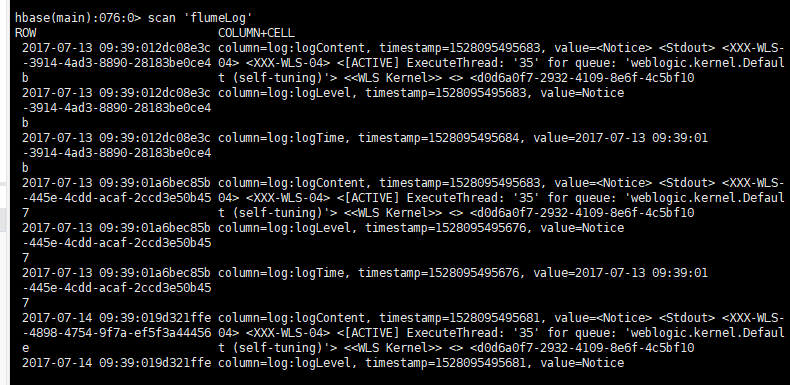需求:通过配置参数,生成fume配置文件,并且上传至目标服务器,且执行flume命令,完成flume日志采集工作。
1、生成配置文件(使用flume+hbase)
a1.sources = r1
a1.sinks = k1
a1.channels = c1
a1.sources.r1.type = exec
a1.sources.r1.command = tail -f /usr/logTest/1.log
a1.sources.r1.checkperiodic = 1000
a1.sources.r1.channels =c1
a1.channels.c1.type = memory
a1.channels.c1.capacity = 10000
a1.channels.c1.transactionCapacity = 1000
a1.sinks.k1.type = org.apache.flume.sink.hbase.AsyncHBaseSink
a1.sinks.k1.channel = c1
a1.sinks.k1.table = flumeLog
a1.sinks.k1.columnFamily = log
a1.sinks.k1.serializer.columns = logTime,logLevel,logContent
a1.sinks.k1.serializer = com.pactera.test.serializer.AsyncHbaseLogEventSerializer
2、实现AsyncHbaseEventSerializer自定义HbaseSink类
public class AsyncHbaseLogEventSerializer implements AsyncHbaseEventSerializer {
private byte[] table;
private byte[] cf;
private byte[][] logBytes;
private byte[][] columnBytes;
private byte[] incrementColumn;
private String rowSuffix;
private String rowPrefixCol;
private byte[] incrementRow;
private KeyType keyType;
private int i=0;
Logger log = LoggerFactory.getLogger(AsyncHbaseLogEventSerializer.class);
public void initialize(byte[] table, byte[] columnFamily) {
log.info("initialize执行顺序是"+(++i)+"\n");
this.table = table;
this.cf = columnFamily;
log.info("table执行顺序是"+table+"cf"+columnFamily+"\n");
}
public void configure(Context context) {
log.info("configure执行顺序是"+(++i)+"\n");
String hbColumns = context.getString("columns", "pCol");
rowPrefixCol = context.getString("rowPrefixCol", "logTime");//主键前缀 一般是mac地址
String suffix = context.getString("suffix", "uuid"); //后缀
if (hbColumns != null && !hbColumns.isEmpty()) {
if (suffix.equals("timestamp")) {
keyType = KeyType.TS;
} else if (suffix.equals("random")) {
keyType = KeyType.RANDOM;
} else if (suffix.equals("nano")) {
keyType = KeyType.TSNANO;
} else {
keyType = KeyType.UUID;
}
// 从配置文件中读出column。
String[] pCols = hbColumns.replace(" ", "").split(",");
columnBytes = new byte[pCols.length][];
for (int i = 0; i < pCols.length; i++) {
// 列名转为小写
columnBytes[i] = pCols[i].getBytes(
Charsets.UTF_8);
}
}
}
public List<PutRequest> getActions() {
log.info("getActions执行顺序是"+(++i)+"\n");
List<PutRequest> actions = new ArrayList<PutRequest>();
if (columnBytes != null) {
byte[] rowKey;
try {
switch (keyType) {
case TS:
rowKey = SimpleRowKeyGenerator.getTimestampKey(rowSuffix);
break;
case TSNANO:
rowKey = SimpleRowKeyGenerator
.getNanoTimestampKey(rowSuffix);
break;
case RANDOM:
rowKey = SimpleRowKeyGenerator.getRandomKey(rowSuffix);
break;
default:
rowKey = SimpleRowKeyGenerator.getUUIDKey(rowSuffix);
break;
}
// for 循环,提交所有列和对于数据的put请求。
for (int i = 0; i < this.logBytes.length; i++) {
PutRequest putRequest = new PutRequest(table, rowKey, cf,
columnBytes[i], logBytes[i]);
actions.add(putRequest);
}
} catch (Exception e) {
throw new FlumeException("Could not get row key!", e);
}
}
return actions;
}
public List<AtomicIncrementRequest> getIncrements() {
log.info("getIncrements执行顺序是"+(++i)+"\n");
List<AtomicIncrementRequest> actions = new ArrayList<AtomicIncrementRequest>();
if (incrementColumn != null) {
AtomicIncrementRequest inc = new AtomicIncrementRequest(table,
incrementRow, cf, incrementColumn);
actions.add(inc);
}
return actions;
}
public void cleanUp() {
// TODO Auto-generated method stub
}
public void setEvent(Event event) {
log.info("setEvent执行顺序是"+(++i)+"\n");
String strBody = new String(event.getBody());
//通过日志内容获取日志实体
log.info("strBody"+strBody);
LogEntity logEntity = LogParser.getLogParser(strBody);
log.info(logEntity.toString());
if(logEntity.toString()!=null){
String[] subBody = {logEntity.getLogTime(),logEntity.getLogLevel(),logEntity.getLogContent()};
log.info("setEvent"+subBody[0]);
if (subBody.length == this.columnBytes.length) {
this.logBytes = new byte[subBody.length][];
for (int i = 0; i < subBody.length; i++) {
this.logBytes[i] = subBody[i].getBytes(Charsets.UTF_8);
if ((new String(this.columnBytes[i])
.equals(this.rowPrefixCol))) {
// rowkey 前缀是某一列的值, 默认情况是mac地址
this.rowSuffix = subBody[i];
}
}
}
}
//String[] subBody = strBody.split(this.columnNamesSplit);
}
public void configure(ComponentConfiguration conf) {
// TODO Auto-generated method stub
}
}
3、如何将文件上传至服务器
我这里使用sftp,将自定义的hbaseSink和agent.conf传至目标服务器文件夹下。
package com.pactera.bi.app.utils;
import java.io.BufferedReader;
import java.io.File;
import java.io.FileInputStream;
import java.io.FileNotFoundException;
import java.io.IOException;
import java.io.InputStream;
import java.io.InputStreamReader;
import java.nio.charset.Charset;
import java.util.Properties;
import java.util.Vector;
import org.apache.commons.io.IOUtils;
import com.jcraft.jsch.Channel;
import com.jcraft.jsch.ChannelExec;
import com.jcraft.jsch.ChannelSftp;
import com.jcraft.jsch.JSch;
import com.jcraft.jsch.JSchException;
import com.jcraft.jsch.Session;
import com.jcraft.jsch.SftpException;
public class JSchUtils {
private static JSch jsch;
private static Session session;
/**
* 连接到指定的IP
*
* @throws JSchException
*/
public static void connect(String user, String passwd, String host, int port) throws JSchException {
jsch = new JSch();// 创建JSch对象
session = jsch.getSession(user, host, port);// 根据用户名、主机ip、端口号获取一个Session对象
session.setPassword(passwd);// 设置密码
Properties config = new Properties();
config.put("StrictHostKeyChecking", "no");
session.setConfig(config);// 为Session对象设置properties
session.setTimeout(5000);// 设置超时
session.connect();// 通过Session建立连接
}
/**
* 关闭连接
*/
public static void close() {
session.disconnect();
}
/**
* 执行相关的命令
*
* @throws JSchException
*/
public static String execCmd(String command) throws JSchException {
Channel channel = null;
try {
if (command != null) {
channel = session.openChannel("exec");
((ChannelExec) channel).setCommand(command);
// ((ChannelExec) channel).setErrStream(System.err);
channel.connect();
InputStream in = channel.getInputStream();
BufferedReader reader = new BufferedReader(new InputStreamReader(in, Charset.forName("UTF-8")));
String buf = null;
StringBuffer sb = new StringBuffer();
while ((buf = reader.readLine()) != null) {
sb.append(buf);
}
/* reader.close();
String out = IOUtils.toString(in, "UTF-8");*/
System.out.println(sb);
return sb.toString();
}
} catch (IOException e) {
e.printStackTrace();
} catch (JSchException e) {
e.printStackTrace();
} finally {
channel.disconnect();
}
return null;
}
/**
* 上传文件
*
* @param directory
* 上传的目录
* @param uploadFile
* 要上传的文件
* @param sftp
* @throws JSchException
* @throws SftpException
* @throws FileNotFoundException
*/
public static void upload(String directory, String uploadFile) throws SftpException, JSchException, FileNotFoundException {
ChannelSftp channelSftp = (ChannelSftp) session.openChannel("sftp");
channelSftp.connect();
try {
channelSftp.cd(directory);
} catch (SftpException e1) {
channelSftp.mkdir(directory);
}
File file = new File(uploadFile);
channelSftp.put(new FileInputStream(file), file.getName());
System.out.println("Upload Success!");
}
/**
* 下载文件
*
* @param src
* @param dst
* @throws JSchException
* @throws SftpException
*/
public static void download(String src, String dst) throws JSchException, SftpException {
// src linux服务器文件地址,dst 本地存放地址
ChannelSftp channelSftp = (ChannelSftp) session.openChannel("sftp");
channelSftp.connect();
channelSftp.get(src, dst);
channelSftp.quit();
}
/**
* 删除文件
*
* @param directory
* 要删除文件所在目录
* @param deleteFile
* 要删除的文件
* @param sftp
* @throws SftpException
* @throws JSchException
*/
public void delete(String directory, String deleteFile) throws SftpException, JSchException {
ChannelSftp channelSftp = (ChannelSftp) session.openChannel("sftp");
channelSftp.connect();
channelSftp.cd(directory);
channelSftp.rm(deleteFile);
}
/**
* 列出目录下的文件
*
* @param directory
* 要列出的目录
* @param sftp
* @return
* @throws SftpException
* @throws JSchException
*/
@SuppressWarnings("rawtypes")
public Vector listFiles(String directory) throws JSchException, SftpException {
ChannelSftp channelSftp = (ChannelSftp) session.openChannel("sftp");
channelSftp.connect();
return channelSftp.ls(directory);
}
}
4、文件和jar包上传至目标Linux服务器 /app/flume/conf文件夹下
文件夹可以随意放,我这里放在了/app/flume/conf文件下,若没有生成文件夹。
jar包是自定义Sink打包的jar包
执行命令:
nohup flume-ng agent --conf /app/flume/conf --conf-file /app/flume/conf/agent.conf -C /app/flume/conf/AsyncHbaseLogEventSerializer.jar --name a1 -Dflume.root.logger=INFO,console >/dev/null 2>log &
我这里使用了nohup和&命令,目的是让该进程在后台作为一个守护进程运行,因为java中使用Jsch执行command的时候,没办法获取flume执行后的状态,所以使用了nohup,能够让java接口能够执行下去。
最终结果入库Hbase数据库:
